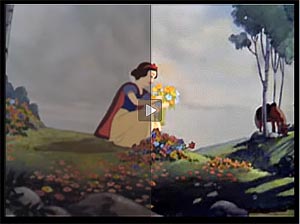|
|
 
|
|
Author
|
Topic: Disney reveals that its digital masters FADE!
|
Frank Angel
Film God

Posts: 5305
From: Brooklyn NY USA
Registered: Dec 1999
|
 posted 10-07-2009 09:32 PM
posted 10-07-2009 09:32 PM





According to Disney, it seems that all the digital masters of their old classics which they have remastered and used on previous DVD releases, seem to fade, and dramatically so, while in the famous Disney vault. And we thought only film fades!
The digitally encoded colors on the masters evidently become unstable while in storage. Disney is just now re-releasing SNOW WHITE AND THE SEVEN DWARFS but they had to "fully restore" it. This is frightening....digital libraries all at risk! Mind you, this title was "fully restored" just a short while ago for the 2001 release. So now we know definatively the shelf life of digital masters to be only 8 to 10 years at best.
The Disney artists worked arduously to get the colors absolutely perfect for their 2001 release, then they put the digital master back in the Disney vault and when they took it out to make the current rerelease, just look at how the colors faded -- thus requiring yet another FULL restoration! At least Disney is honest and is not afraid to show the industry the problem. Just to dramatically demonstrate how much work they had to do, Disney shows a frame in split screen in their current TV ad campaign for the new SW&7D BluRay release. Imagine, needing to restore every digital master after only a few years. That's worse than low fade film!
Now this is not necessarily true for all digital masters, it only proves that Disney masters fade or at least Disney is the only studio that seems to be forthright about it, even showing the fade in those split screens in their ads for every DVD release -- here:

Oh my.
| IP: Logged
|
|
|
|
|
|
|
|
Bobby Henderson
"Ask me about Trajan."

Posts: 10973
From: Lawton, OK, USA
Registered: Apr 2001
|
 posted 10-08-2009 12:12 AM
posted 10-08-2009 12:12 AM




quote:
According to Disney, it seems that all the digital masters of their old classics which they have remastered and used on previous DVD releases, seem to fade, and dramatically so, while in the famous Disney vault. And we thought only film fades!
Although the idea is pretty hilarious, Disney created a new master because the old master was derived with older equipment inferior for use related to Blu-ray. It's a pretty common problem in why certain catalog movie titles don't look so good when released on Blu-ray.
Telecine equipment that runs a film print through in real time with a high definition camera recording it can deliver good results on DVD. The limits of standard definition and its muted color gamut range hide many of the flaws in this approach. When that same, dusty old telecine master is reused as a source for Blu-ray release the flaws become more noticeable.
It costs more money to have a film print carefully scanned and post processed with digital intermediate techniques. Obviously Disney chose this modern approach for creating a new master for this home video release of Snow White.
IMHO, any movie released on Blu-ray should be coming from a scan and digital intermediate source. The only exceptions should be movies that were shot electronically instead of shot on film. But even many those "digital" movies receive digital intermediate style treatment to correct color differences between scenes, CGI plates, etc.
| IP: Logged
|
|
|
|
|
|
|
|
|
|
Bobby Henderson
"Ask me about Trajan."

Posts: 10973
From: Lawton, OK, USA
Registered: Apr 2001
|
 posted 10-29-2009 06:47 PM
posted 10-29-2009 06:47 PM




I think the "remastering" has more to do with other factors.
For instance, there is a GIANT level of varying quality in how movie film negatives, inter-positives are acquired into the digital domain. An old HD telecine machine playing back the movie in real time is going to deliver shitty results compared to the latest film scanning systems where each frame is precisely scanned, but kind of slowly scanned as well. These systems have gone through a few generations of changes just over the last decade.
On top of that, numerous choices can be made in how the movie is digitally acquired -like the resolution setting (2K, 4K, 1080p, 1080i, etc.).
Then there's the digital intermediate that gets tuned and tweaked following the scan -that is if there's any digital intermediate at all. Lots of choices get made there.
Summing it up, one digital master certainly is not the same as the next. Even on the same movie. Just look at the differences on the two Blu-ray versions of The Fifth Element. As technology improves there are good reasons to dig out archival film elements and digitally remaster them again.
| IP: Logged
|
|
|
|
|
|
All times are Central (GMT -6:00)
|
|
Powered by Infopop Corporation
UBB.classicTM
6.3.1.2
The Film-Tech Forums are designed for various members related to the cinema industry to express their opinions, viewpoints and testimonials on various products, services and events based upon speculation, personal knowledge and factual information through use, therefore all views represented here allow no liability upon the publishers of this web site and the owners of said views assume no liability for any ill will resulting from these postings. The posts made here are for educational as well as entertainment purposes and as such anyone viewing this portion of the website must accept these views as statements of the author of that opinion
and agrees to release the authors from any and all liability.
|

 Home
Home
 Products
Products
 Store
Store
 Forum
Forum
 Warehouse
Warehouse
 Contact Us
Contact Us




 Printer-friendly view of this topic
Printer-friendly view of this topic












![[Roll Eyes]](rolleyes.gif)






